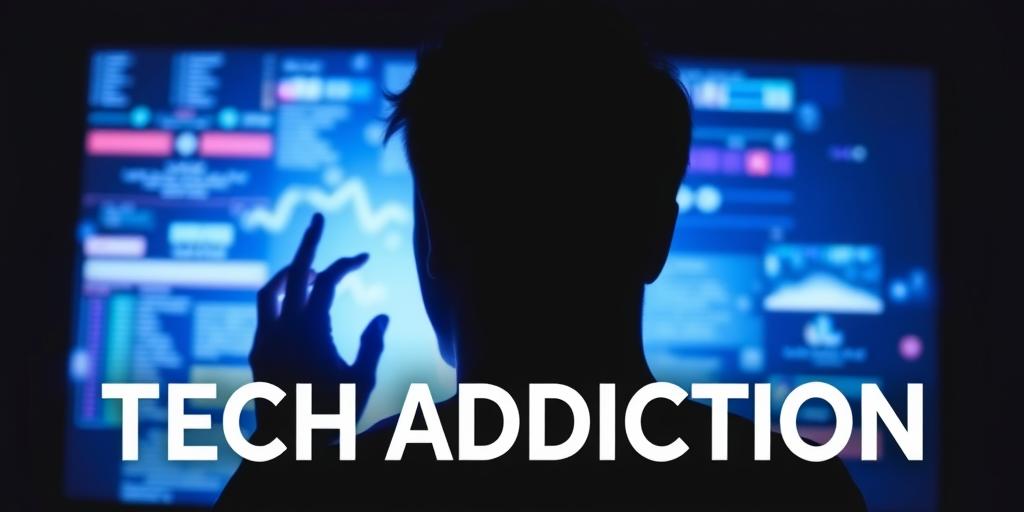The Allure and Shadow of Our Digital World
We live in an age dominated by technology. Smartphones, social media, and instant connectivity have become integral to our daily routines. But beneath the surface of convenience and progress lies a darker side: tech addiction. What starts as a helpful tool can quickly morph into a dependency that affects our mental and physical well-being.
What Exactly is Tech Addiction?
Tech addiction, also known as internet addiction or digital addiction, is a behavioral addiction characterized by the compulsive use of technology, despite negative consequences. It's not just about spending a lot of time online; it’s about the impact that excessive use has on your life. Think of it as an inability to control the impulse to use technology, leading to problems in relationships, work, and health.
The Triggers and Traps
Several factors contribute to tech addiction:
- Dopamine Rush: Social media platforms and apps are designed to release dopamine in our brains, creating a sense of pleasure and reward. This makes us want to keep scrolling, liking, and engaging.
- Fear of Missing Out (FOMO): The constant stream of updates and notifications can create a fear of missing out on something important or exciting. This drives us to compulsively check our devices.
- Escape from Reality: Technology can provide an escape from stress, anxiety, or boredom. It's easy to lose yourself in a virtual world, neglecting real-life responsibilities.
The Toll on Mental Health
Tech addiction can have serious consequences for our mental health:
- Anxiety and Depression: Studies have shown a link between excessive screen time and increased rates of anxiety and depression. The constant comparison to others on social media can lead to feelings of inadequacy and low self-esteem.
- Sleep Disturbances: The blue light emitted by screens can interfere with our natural sleep patterns, leading to insomnia and fatigue. Lack of sleep can exacerbate mental health issues.
- Social Isolation: While technology is supposed to connect us, it can also lead to social isolation. Spending too much time online can replace real-life interactions, leading to feelings of loneliness and disconnection.
Physical Health in the Digital Age
Beyond mental health, tech addiction takes a toll on our physical well-being:
- Eye Strain and Headaches: Staring at screens for long periods can cause eye strain, headaches, and blurred vision.
- Musculoskeletal Problems: Repetitive movements, such as typing and scrolling, can lead to carpal tunnel syndrome and other musculoskeletal problems.
- Sedentary Lifestyle: Spending too much time online often means spending less time being physically active. This can contribute to weight gain, cardiovascular problems, and other health issues.
Breaking Free: Steps to Regain Control
Recognizing the problem is the first step. Here are some strategies to help you break free from tech addiction:
- Set Limits: Establish specific times for using technology and stick to them. Use apps or device settings to track and limit your screen time.
- Create Tech-Free Zones: Designate certain areas in your home as tech-free zones. This could be the bedroom, dining room, or any space where you want to disconnect.
- Find Alternative Activities: Engage in hobbies, exercise, or social activities that don't involve technology. Rediscover the joy of real-life experiences.
- Practice Mindfulness: Pay attention to your thoughts and feelings when you feel the urge to use technology. This can help you identify triggers and develop coping strategies.
- Seek Support: Talk to a therapist, counselor, or support group. Sharing your struggles and getting professional help can make a big difference.
Navigating the Future
Technology is not inherently bad. When used in moderation and with intention, it can enhance our lives. However, it's crucial to be aware of the potential risks and take steps to protect our well-being. By setting boundaries, practicing mindfulness, and prioritizing real-life connections, we can harness the power of technology without falling prey to its dark side. Let's strive for a balanced and healthy relationship with our digital world.









